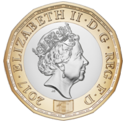
Back Pond sterling Afrikaans Libra esterlina AN جنيه إسترليني Arabic جنيه استيرلينى ARZ Llibra esterlina AST Funt sterlinq Azerbaijani Фунт стэрлінгаў Byelorussian Фунт стэрлінгаў BE-X-OLD Британска лира Bulgarian পাউন্ড স্টার্লিং Bengali/Bangla
| |||||
| ISO 4217 | |||||
|---|---|---|---|---|---|
| Code | GBP (numeric: 826) | ||||
| Subunit | 0.01 | ||||
| Unit | |||||
| Unit | pound | ||||
| Plural | pounds | ||||
| Symbol | £ | ||||
| Denominations | |||||
| Subunit | |||||
| 1⁄100 | penny | ||||
| Plural | |||||
| penny | pence | ||||
| Symbol | |||||
| penny | p | ||||
| Banknotes | |||||
| Freq. used | |||||
| Rarely used | |||||
| Coins | |||||
| Demographics | |||||
| Date of introduction | c. 800 | ||||
| User(s) | |||||
| Issuance | |||||
| Central bank | Bank of England | ||||
| Website | www | ||||
| Printer | De La Rue[1] | ||||
| Website | www | ||||
| Mint | Royal Mint | ||||
| Website | www | ||||
| Valuation | |||||
| Inflation | 3.2% or 2.3% | ||||
| Source | Office for National Statistics, 20 November 2024[2] | ||||
| Method | CPIH or CPI | ||||
| Pegged by | see § Pegged currencies | ||||
| This article is part of a series on |
| Politics of the United Kingdom |
|---|
 |
|
|
Sterling (ISO code: GBP) is the currency of the United Kingdom and nine of its associated territories.[3] The pound (sign: £) is the main unit of sterling,[4][c] and the word pound is also used to refer to the British currency generally,[7] often qualified in international contexts as the British pound or the pound sterling.[4]
Sterling is the world's oldest currency in continuous use since its inception.[8] In 2022, it was the fourth-most-traded currency in the foreign exchange market, after the United States dollar, the euro, and the Japanese yen.[9] Together with those three currencies and the renminbi, it forms the basket of currencies that calculate the value of IMF special drawing rights. As of late 2022, sterling is also the fourth most-held reserve currency in global reserves.[10]
The Bank of England is the central bank for sterling, issuing its own banknotes and regulating issuance of banknotes by private banks in Scotland and Northern Ireland. Sterling banknotes issued by other jurisdictions are not regulated by the Bank of England; their governments guarantee convertibility at par. Historically, sterling was also used to varying degrees by the colonies and territories of the British Empire.
Cite error: There are <ref group=lower-alpha> tags or {{efn}} templates on this page, but the references will not show without a {{reflist|group=lower-alpha}} template or {{notelist}} template (see the help page).
- ^ "Our banknotes". Bank of England. 31 October 2022. Retrieved 28 November 2022.
- ^ "Inflation and price indices". Office for National Statistics. 20 November 2024. Retrieved 20 November 2024.
- ^ Hashimzade, Nigar; Myles, Gareth; Black, John (2017). A Dictionary of Economics (5 ed.). Oxford University Press. ISBN 9780198759430.
Sterling: The UK currency. The name originated from the pound Easterling, formerly used in trade with the Baltic.
- ^ a b Barber, Katherine, ed. (2004). "Pound". Canadian Oxford Dictionary (2 ed.). Oxford University Press. ISBN 9780195418163.
Pound:2. (in full pound sterling) (pl. same or pounds) the chief monetary unit of the UK and several other countries.
- ^ "Pounds, shillings and pence". Royal Mint.
- ^ "UK Notes and Coins". Bank of England. "The pound sterling is the official currency in the United Kingdom."
- ^ Moles, Peter; Terry, Nicholas (1999). The Handbook of International Financial Terms. ISBN 9780198294818.
Sterling (UK).: The name given to the currency of the United Kingdom (cf. cable). Also called pound sterling or pounds.
- ^ Rendall, Alasdair (12 November 2007). "Economic terms explained". BBC News. Archived from the original on 3 May 2008. Retrieved 14 February 2014.
- ^ "Triennial Central Bank Survey" (PDF). BIS. 27 October 2022. Retrieved 28 December 2023.
- ^ "Currency Composition of Official Foreign Exchange Reserves". International Monetary Fund. 23 December 2022. Retrieved 31 December 2022.



